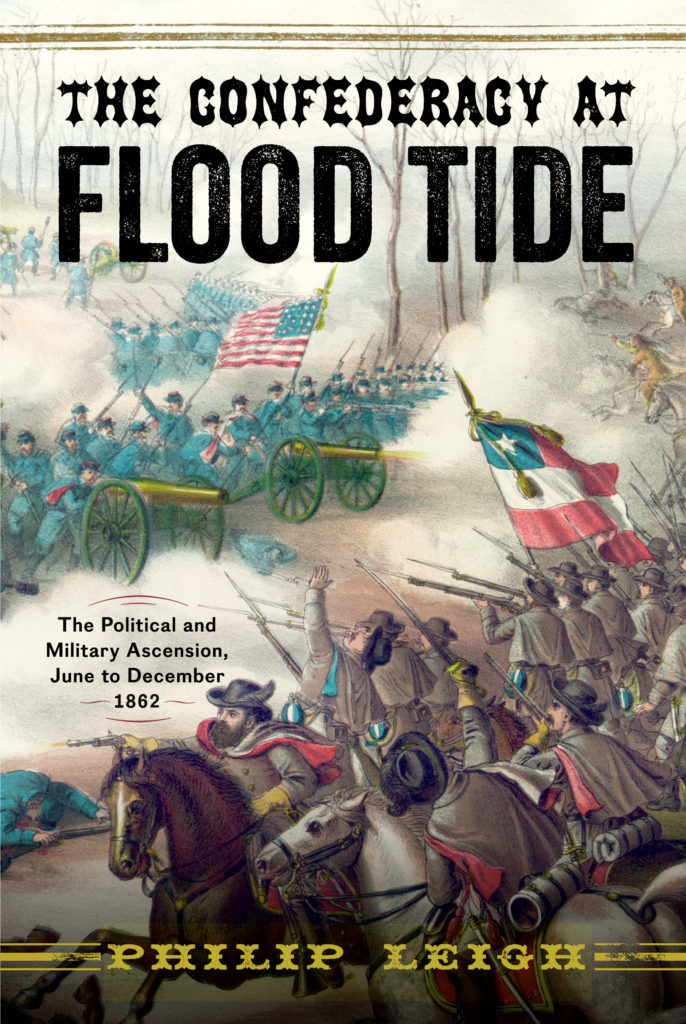

The Confederacy at Flood Tide
The Political and Military Ascension, June to December 1862
by Philip Leigh
$28.00 Add to Cart Save 25% on every book by joining our Book Club


by Philip Leigh
The Fleeting Moment When the Confederate States of America Had the Best Opportunity to Achieve Independence and Why Their Efforts Failed
The first six months of 1862 provided a string of Federal victories in the West at Mill Springs, Fort Donelson, Pea Ridge, Island Number 10, and Shiloh. In May, New Orleans fell, and Union General George McClellan’s army was so close to the Confederate capital of Richmond, Virginia, that the troops could set their watches by the city’s church bells. But then the unexpected happened. In June, Robert E. Lee’s Army of Northern Virginia pushed McClellan’s much larger army back to the James River. In Europe, Confederate diplomats sought international recognition for the Confederate States of America, which was made even more attractive now that a shortage of cotton made the powerful textile interests anxious to end the war. Further tipping the balance, in July, the Confederacy secretly ordered two of the latest ironclad ships from England’s famous Laird Shipyard—the same yard that built the commerce raider Alabama. These steam-powered ironclads would be far superior to anything in the Federal navy. While the “high tide” of the Confederacy is often identified as Pickett’s Charge during the Battle of Gettysburg in July 1863, the most opportune time for the Confederacy vanished seven months earlier, coinciding with President Abraham Lincoln’s Emancipation Proclamation on January 1, 1863 and the failure of the secessionist states to be recognized as a sovereign nation.
As Philip Leigh explains in The Confederacy at Flood Tide: The Political and Military Ascension, June to December 1862 on every battlefront and in the governmental halls of Europe, the Confederate effort reached its furthest extent during the second half of 1862. But with the president’s proclamation, battlefield reverses, Europe’s decision to reject Confederate diplomatic overtures, and Britain’s decision to halt the sale of the ironclads, the opportunity for Confederate success ended. The Confederacy would recede, and the great battles of 1863 and 1864 only marked the Southerners’ tenacity and stubborn belief in a lost cause.

Philip Leigh is the author of a number of books, including Lee’s Lost Dispatch and Other Civil War Controversies, Southern Reconstruction, and Trading with the Enemy: The Covert Economy During the American Civil War. From 2012 to 2015 he was a regular contributor to the New York Times Disunion Series, which commemorated the Sesquicentennial of the Civil War. He has an engineering degree from the Florida Institute of Technology and an MBA from the Kellogg School of Management at Northwestern University.
“The Confederacy at Flood Tide ties together the far-flung theaters of war and the contemporaneous political situation, which emphasizes the interconnections among them. Mr. Leigh does not accept offhand the standard versions presented as history, but drills into the events without preconceptions, the better to determine causes and impacts.”—Joseph Rose, author of Grant Under Fire
“With The Confederacy at Flood Tide, Leigh interweaves narrative and analysis to upend our conventional wisdom about the rise and fall of the South’s fortunes during the Civil War. A must read for anyone looking for a deeper understanding of those critical months in 1862, when the South could, for just a moment, see the possibility of victory.” —Clay Risen, New York Times
“Philip Leigh has produced a highly-readable history of a crucial period of the Civil War. It is a fine synthesis, he gives the reader a solid grounding of the battles, linked with a valuable discussion of how the leaders, both military and political, effected them. Perhaps the most interesting part of this work is the way in which Leigh places the events he discusses into the global context, connecting what was happening in the U.S. with public opinion, government policies, and social forces in Europe and Mexico. This is a fine addition to the current scholarship of the war.”—Frank Varney, author of General Grant and the Rewriting of History